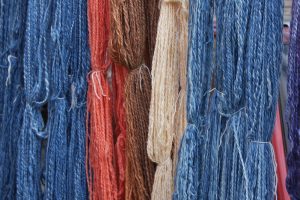WEEKS 4-5: INTRODUCTION TO SUSTAINABLE FASHION This module examines materials and processes in the Textile and Fashion industries that harm the environment, and new solutions being developed.
1.How big is fashion’s carbon footprint? Watch/Read this 5-part NPR project; be sure to check out the historic and contemporary photos for “People”: Planet Money Explores the Economics of T-shirts
1: Cotton 2: Machines 3: People 4: Boxes 5: You
2.Listen to this podcast about “How the Fashion Industry is Responding to Climate Change” (~35 min.)
3. Read “Want to Make it Big in Fashion? Think Small.” By Guy Trebay, The New York Times (August 19, 2020).
4. Check this list about fashion companies making a difference from The Good Trade and choose one to blog about. Add your blog here. See Blackboard Module 2 for details.
WEEK 6: DYES

Color is a major factor in creating and marketing a desirable line of apparel. All dyes were made from natural sources (animal, plant and mineral) until the mid-19th century, when William Henry Perkin created the first chemical dye from coal tar, a purplish color he called “Mauveine.” Synthetic dyes are toxic and cause great harm to the environment. Review the content below sequentially.
- Watch this TEDx Talk by Susan Clark “A Brief History of the Invention of Modern Color” (~10 min. long)
- Read this article about dye pollution “Asian Rivers are Turning Black. And our Colorful Closets are to Blame” by Helen Regan. CNN Style, 28th September 2020 (Dhaka, Bangladesh)
- Historical methods: Watch this meditative film about a return to historic natural dyeing “In Search of Forgotten Colors: Sachio Yoshioka and the Art of Natural Dyeing”(~18 min) Victoria & Albert Museum
- Modern Solutions: Watch this video summarizing how the Colorifix Company is working on eliminating water pollution and usage issues Company video (~4 min)
- Modern Solutions: Read this article by Emma Woollacott “Making Beautiful Colors Without Toxic Chemicals” BBC (Jan. 31, 2020)
WEEK 7: BIOSYNTHETIC MATERIALS Synthetic fibers are not biodegradable, meaning that they will sit in a landfill for hundreds of years before they fully decompose. Although the development of synthetic polymers was revolutionary for fashion, eco-conscious companies are now developing biosynthetic fibers for the industry.
- Intro: What are Biosynthetics? Read this article by Textile Exchange to gain a better understanding of these innovative materials
- Watch this video about The Future of Fashion: Bolt Threads (~4 min)
- Review the Bolt Threads company website
- The industry questions biosynthetics. Read “Is Faux Leather Better than the Real Thing? These 3 Designers Say Yes” by Emily Farra Vogue (Nov. 8, 2018)
Transforming the Environment Moving in a more proactive direction, forward-thinking designers are creating fabrics that use waste product as fiber, and some can actually clean the air we breathe by eliminating CO2 emissions.
- Read this article “Do you Have it in Green? Living fabrics that can help clean the air” The Guardian (Feb. 8, 2020)
- Read more about Charlotte McCurdy and Post Carbon Labs
- Review the 2019 Cooper-Hewitt Triennial exhibition, featuring the work of McCurdy and the latest experimental design and biosynthetic fabrics
Using Waste Other design companies are creating more sustainable fabrics by manufacturing biodegradable fibers from food waste. Here are a few products that have gained traction in the last few years:
- Orange Fiber Review “Fabrics” and “Collections”
- Ferragamo’s Orange Fiber Capsule Collection
- Piñatex Pineapple fiber material
- Duedilatte Milk Fabric Company Video
- Micro ‘be’ Fabric Fermented wine fabric created by Donna Franklin & Gary Cass (2012), also featured in WIRED UK. The “Beer Dress” is a later version by the same design team, Donna Franklin & Gary Cass (2015)
Cellulosic Fibers Review the Fashioned from Nature Exhibition at the V & A Museum, London (April 2018-January 2019)
- Watch the “Fashioned from Nature” Exhibition Trailer (~1 min.)
- Diana Scherer, Artist creates plant roots for 3-d textiles (~4 min.)
- Pulp-it video summarizing the processes used by Pulp-it to create Wearable nonwoven “paper” made from cellulosic fibers (~4.5 min.)
“Environmentalists sound alarm about Biotech fabrics” Innovation in Textiles-Editorial by Jana Bukolovska (9/17/18)
WEEKS 8-9: Compare/Contrast Biosynthetic Paper See Blackboard for assignment details on your compare/contrast paper on biosynthetics
Print this page


